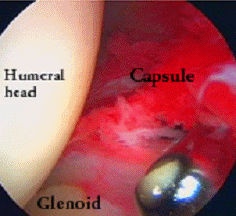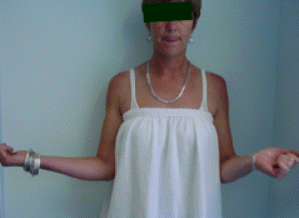
Movement of a frozen shoulder can be painful, but will not cause damage, writes dr Joe de Beer, arthroscopic shoulder surgeon, and dr Karin van Rooyen. In an in-depth article they explain the facts about this condition associated with severe pain and restriction of movement.
Frozen Shoulder is a condition with no known cause in the majority of cases, with spontaneous onset. It is most common in females (40-50 years) but could affect males and other age groups. It may follow shoulder injuries, operations or be associated with medical conditions like diabetes mellitus.
It is referred to as “adhesive capsulitis” suggesting that the capsule is inflamed and adhering (clinging) to the joint, causing pain and limitation of motion.
SYMPTOMS
Severe pain and restriction of movement. Night pain can be especially troublesome and with sudden movements intense pain may follow, e.g. reaching out to grab something. Reaching the hand up behind the back is usually a problem due to the restriction. To reach overhead the shoulder blade has to be lifted (see picture below).
Pain may be felt in the shoulder, spreading up the neck and even down the arm into the hand.
In some cases the shoulder blade may protrude at the back, referred to as “pseudo-winging” of the scapula.
NATURAL PROGRESSION
The condition runs its course over many months, anything from 6months to as long as 3 years, virtually having its “own mind”.
THE FOUR STAGES:
| Inflammation | Freezing | Frozen | Thawing |
Stage 1: Inflammation (0-3 months). The lining of the joint (synovium) is inflamed. Moderately severe pain.
Stage 2: “Freezing Stage”(3-9 months) Synovitis and scar formation in the underlying capsule. Severe pain.
Stage 3: “Frozen Stage” (9-15 months) Minimal pain, marked stiffness due to scar formation in capsule.
Stage 4: “Thawing Stage”(15-24 months) Little pain, movement increases.
| This is an arthroscopic view of the inside of a frozen shoulder in stages I and II- note the intensely red and inflamed capsule (lining) of the joint – a very painful phase.This is the view which the surgeon sees on a TV monitor with the arthroscope in the joint. The arthroscopic surgical instrument can be seen entering the joint. |
PROGNOSIS
Most clear up in 1-2 years, even without any treatment - in other words, it is usually a self-limiting condition if one waits “long enough”.
CLINICAL EXAMINATION
Motion of the shoulder is restricted.
| This man can elevate his right arm normally. His left arm, with a frozen shoulder, can only be elevated by lifting the shoulder blade. |
| External rotation: with the upper arm by the side, rotate the forearm outwards. In this lady the right side is normal. The left shoulder is frozen with limited external rotation. |
TREATMENT
Cortisone Injection into the joint may be helpful in stage 1and 2 (see above). Given early, such an injection may completely cure the condition. During the later stages it has no effect.
Physiotherapy, which should include gentle stretching exercises, is beneficial in most cases.
Manipulation under anaesthesia: The capsule is torn by the surgeon manipulating the arm under anaesthesia- this may be of benefit during the later stages of the disease.
Arthroscopic capsulotomy: In exceptional cases, when surgery is indicated, we prefer an arthroscopic operation: The tight, inflamed capsule is divided under direct arthroscopic control (see picture below) until a full range of motion is achieved (An arthroscope is a thin tube with a camera attached - the operation is done through small holes with the surgeon viewing the procedure on a TV monitor). After the operation, exercises are done, maintaining the motion while the arm is kept pain-free with a continuous nerve block (2-3 days).
| Arthroscopic Capsulotomy: The delicate arthroscopic cutting instrument (diameter 4mm) can be seen dividing the tight, inflamed capsule. |
Frequently asked questions:
Q: May I use my arm while suffering with a frozen shoulder?
A: Yes, definitely- movement is rather good than bad, although painful. During motion of the shoulder one pulls on the tight, inflamed capsule resulting in pain, but not damage.
Q: Is Frozen Shoulder caused by an injury?
A: Only in certain cases, but most are ”out of the blue”, due to no apparent cause.
Q: If a patient develops a frozen shoulder after a shoulder operation does it imply that “something has gone wrong”?
A: No, not necessarily: certain patients are more prone to developing a frozen shoulder than others, e.g. females in the middle age group as well as diabetics.
Q: After recovery, could the Frozen Shoulder come back again?
A: It usually never recurs in the same shoulder and very rarely in the other shoulder.
Q: Does Frozen Shoulder always require treatment or even operation?
A: Treatment, especially arthroscopic Capsulotomy, speeds up recovery, but if you can live with the discomfort, you may safely await spontaneous recovery.
Q: How long will I take to get better?
A: The total duration of the process is anything from 6 months to 3 years. It is difficult, in a specific person, to predict the duration.
Written by drr Joe de Beer and Karin van Rooyen.




 Publications
Publications
 Partners
Partners






















